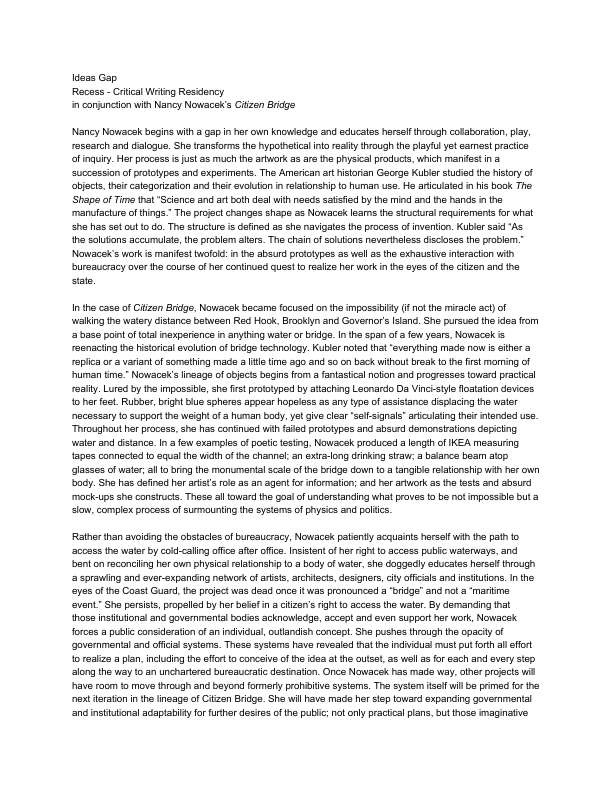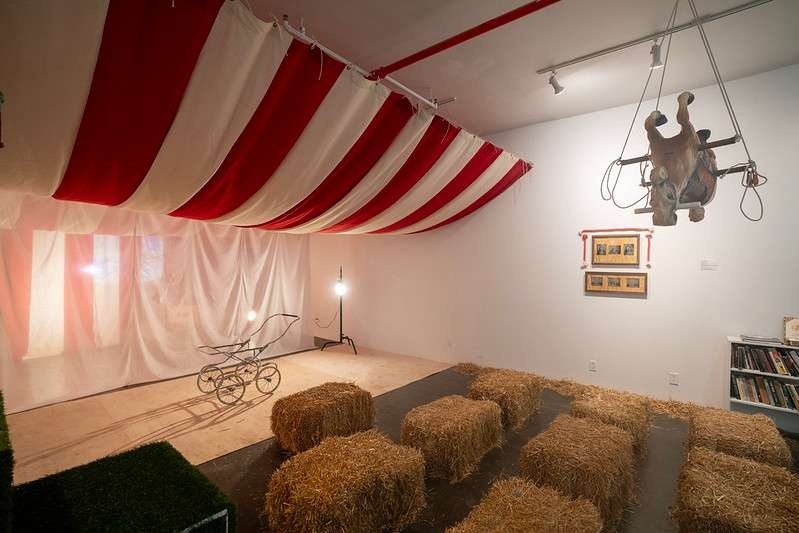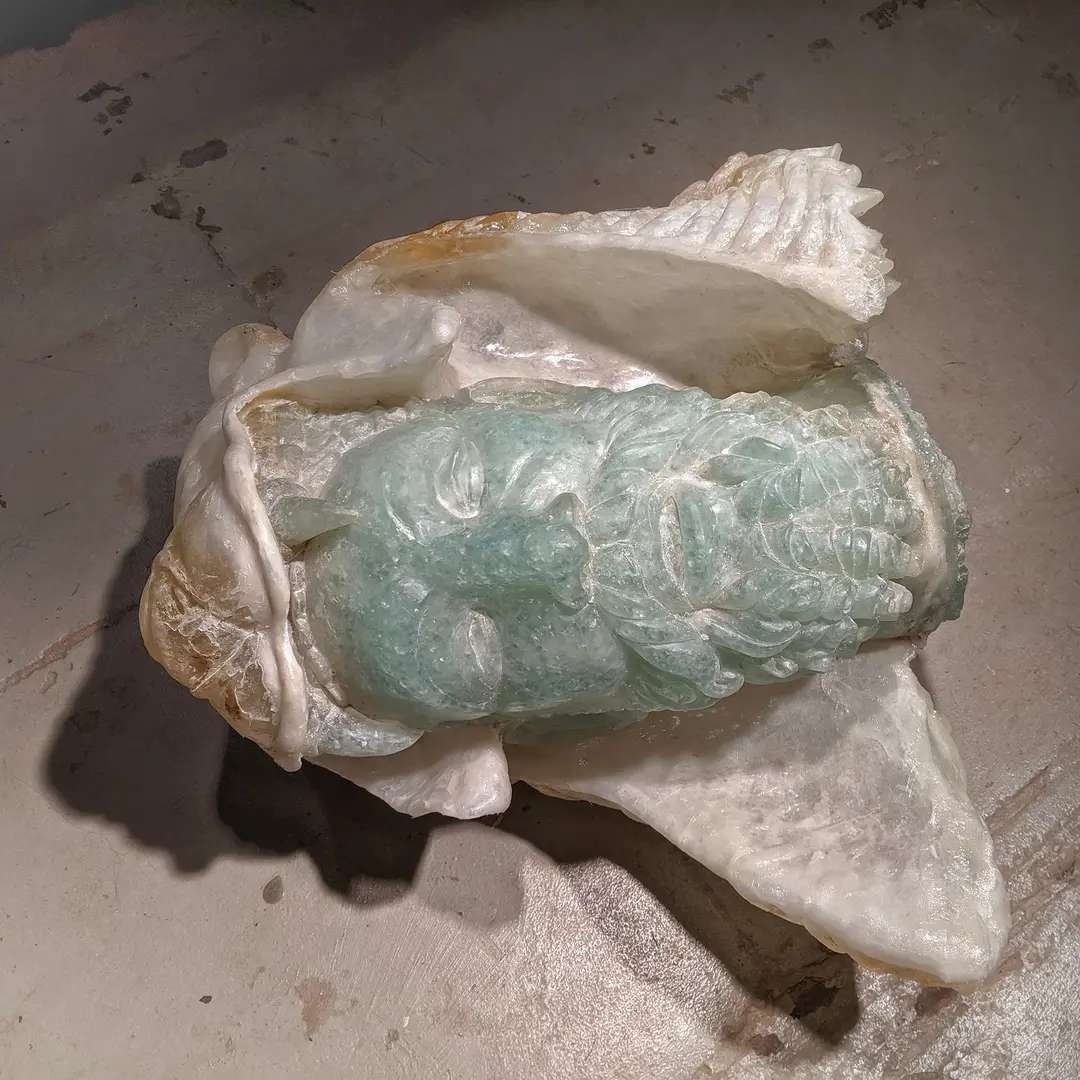In conjunction with her text, Conant created a website which examines past attempts to walk on water.
Nancy Nowacek begins with a gap in her own knowledge and educates herself through collaboration, play, research and dialogue. She transforms the hypothetical into reality through the playful yet earnest practice of inquiry. Her process is just as much the artwork as are the physical products, which manifest in a succession of prototypes and experiments. The American art historian George Kubler studied the history of objects, their categorization and their evolution in relationship to human use. He articulated in his book The Shape of Time that “Science and art both deal with needs satisfied by the mind and the hands in the manufacture of things.” The project changes shape as Nowacek learns the structural requirements for what she has set out to do. The structure is defined as she navigates the process of invention. Kubler said “As the solutions accumulate, the problem alters. The chain of solutions nevertheless discloses the problem.” Nowacek’s work is manifest twofold: in the absurd prototypes as well as the exhaustive interaction with bureaucracy over the course of her continued quest to realize her work in the eyes of the citizen and the state.
In the case of Citizen Bridge, Nowacek became focused on the impossibility (if not the miracle act) of walking the watery distance between Red Hook, Brooklyn and Governor’s Island. She pursued the idea from a base point of total inexperience in anything water or bridge. In the span of a few years, Nowacek is reenacting the historical evolution of bridge technology. Kubler noted that “everything made now is either a replica or a variant of something made a little time ago and so on back without break to the first morning of human time.” Nowacek’s lineage of objects begins from a fantastical notion and progresses toward practical reality. Lured by the impossible, she first prototyped by attaching Leonardo Da Vincistyle floatation devices to her feet. Rubber, bright blue spheres appear hopeless as any type of assistance displacing the water necessary to support the weight of a human body, yet give clear “selfsignals” articulating their intended use. Throughout her process, she has continued with failed prototypes and absurd demonstrations depicting water and distance. In a few examples of poetic testing, Nowacek produced a length of IKEA measuring tapes connected to equal the width of the channel; an extralong drinking straw; a balance beam atop glasses of water; all to bring the monumental scale of the bridge down to a tangible relationship with her own body. She has defined her artist’s role as an agent for information; and her artwork as the tests and absurd mockups she constructs. These all toward the goal of understanding what proves to be not impossible but a slow, complex process of surmounting the systems of physics and politics.
Rather than avoiding the obstacles of bureaucracy, Nowacek patiently acquaints herself with the path to access the water by coldcalling office after office. Insistent of her right to access public waterways, and bent on reconciling her own physical relationship to a body of water, she doggedly educates herself through a sprawling and everexpanding network of artists, architects, designers, city officials and institutions. In the eyes of the Coast Guard, the project was dead once it was pronounced a “bridge” and not a “maritime event.” She persists, propelled by her belief in a citizen’s right to access the water. By demanding that those institutional and governmental bodies acknowledge, accept and even support her work, Nowacek forces a public consideration of an individual, outlandish concept. She pushes through the opacity of governmental and official systems. These systems have revealed that the individual must put forth all effort to realize a plan, including the effort to conceive of the idea at the outset, as well as for each and every step along the way to an unchartered bureaucratic destination. Once Nowacek has made way, other projects will have room to move through and beyond formerly prohibitive systems. The system itself will be primed for the next iteration in the lineage of Citizen Bridge. She will have made her step toward expanding governmental and institutional adaptability for further desires of the public; not only practical plans, but those imaginativeand playful. The latter are those ideas that further a greater understanding of culture and human life.
Nowacek’s project engenders personal relationships between the artist and government bodies. Her work and the trajectory of objects she has developed diagram the dynamic between an individual and his/her surrounding governmental and official structures. The nature of government is such that it structures previously established needs and problems, hence a exclusion of invention. By the same token, governmental change comes from individuals generating new ideas and problems. She finds a parallel in the impossibility she confronts as an individual with the systemic challenges she faces as a citizen. Therefore, her personal block is equivalent to a universal problem in need of solving. The cruciality of the problem and the necessity for her groundbreaking becomes apparent as her process reveals its reliance on governmental and institutional systems.
The evolution of government can be likened to Nowacek’s historically referential progression of work made in her effort toward grounding the miraculous act of walking on water. Nowacek seeks invention by locating areas of her own inexperience, but also as a way to bring the absurd town to earth. Benedictus de Spinoza writes that a miracle is “a sheer absurdity,” in other words, he defines a miracle as a “natural phenomenon which surpasses, or is believed to surpass, human powers of comprehension.” Nowacek’s act of walking on water or traversing the waterway will be no miracle once her work is complete. She begins with a fantasy of the miracle and disassembles it by confronting it with information until it is no longer miraculous but a fact.
While the Citizen Bridge is not a game, Nowacek surmounts governmental obstacles with the energetic experimentation of play. Never entertaining discouragement, she uses play as a tool for transforming the absurd, through a progression of experimental iterations, into truth. She embraces absurdity as a necessary and driving force on the citizen’s route to realizing the impossible.
Angela Conant, 2013
About the artist
Explore/Archive
See allOctober 2025
streamlined reflections, courtesy of noise canceling headphones
Gabrielle Rucker
Gabrielle Rucker reflects on the radical intimacy and auditory life at the heart of Deli Radio
July 2025
Tell My Jockey: CUNTRY’s Discourse From the Horse’s Mouth
Ericka Pérez
Assembly fellow Ericka Pérez reflects on clowning, resistance, and CUNTRY’s radical refusal to perform.
April 2025
The Second Head of Hercules: Art and Resistance Through Four Years of Upheaval
Shakeem Floyd
written in conjunction with artist Onyedike Chuke's Session x Assembly project, The Forever Museum Archive: Circa 2020_An Object







